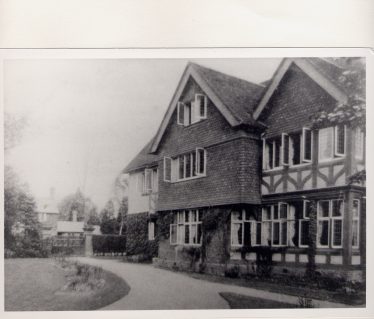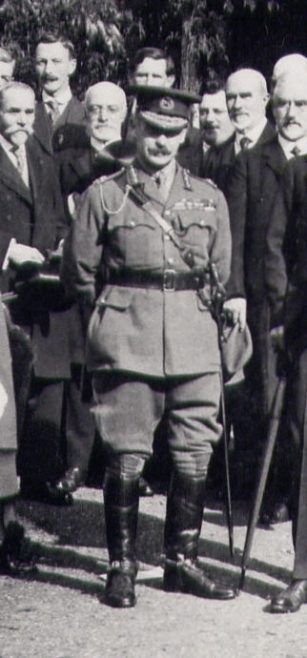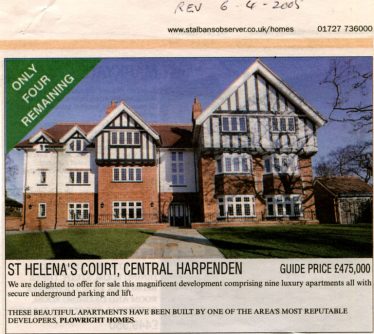
St Helena’s, at the time it was a school (c.1910). Credit: LHS archives, Harpenden Collection
After the First World War, the people of Harpenden raised the sum of £5,456 as a contribution to a war memorial for those who had died. All of us are familiar with the Memorial Cross on Church Green which records the names, ranks and Units of the dead. However the Cross was only part of Harpenden’s tribute: the remaining funds were used to create the Memorial Nursing Centre ‘for the relief of suffering and prevention of sickness and disease’. You may be surprised to learn that what was our very own Community Meeting Point now occupies those premises!
St Helena ’s, as the property used to be known, was built in 1897 as a girls’ school (see article in Education). It was purchased by the Memorial Nursing Centre Committee in 1919 for £3,100 as the cost of providing new building would have been more than the fund could bear. Some structural alterations and additions were made (including provision of central heating and a hot water system) and the building was redecorated both inside and out. The committee considered itself ‘fortunate’ to have obtained such a suitable building together with grounds described as comprising lawns, flower border and a vegetable garden. It is good to see what Paul and Howard have done to restore the attractiveness of the original site (but when are ‘home-grown’ carrots and potatoes going to be on the menu in the Day Centre?)
Official opening

Lieutenant-General the Lord Cavan, on the day he dedicated the Harpenden War Memorial and opened the Memorial Nursing Home – 9 October 1920. Credit: LHS archives – Harpenden UDC Collection
The Memorial Nursing Centre was opened at 3.30pm on Saturday October 9th 1920, by Lieutenant-General the Earl of Cavan, General Officer Commanding-in-Chief, Aldershot Command.
At that time, as he entered the building he would have first stepped into a spacious hall with the names of the fallen men inscribed on its walls. Visitors and children attending the clinic used this as a waiting area. On the north side of the building was the Dental and Ophthalmic Clinic with a dark room.
The east side of the building contained the District Room for treatment of minor injuries by the resident nurse and opposite was the Massage and Electro-Therapeutic Clinic where ex-Servicemen were treated. The large room forming the south-west angle of the building, was used as the Maternity and Infant Welfare Room.
Upstairs there were two wards containing two beds each. Very seriously ill or emergency patients could be dealt with here, and exceptionally*, maternity cases. Each of the three District Nurses had a bedroom here and shared a bathroom, dining room and sitting room. On the very top floor were the Caretaker’s rooms, a storeroom and a spare bedroom for emergencies.
Army billets, flats for local families
In 1941, during the Second World War, all the Clinics were transferred to the Red House and 40 Luton Road was requisitioned by the Army as a billet for ATS girls working at Luton Hoo (then the headquarters of the Eastern Command).
After the end of the war, in August 1946, it was decided to convert 40 Luton Road into five flats and the first families moved in during December of that year. However, already by 1949 there was another change of plan; the families were moved out, the building was de-requisitioned and plans were afoot to transfer the clinics back from the Red House.
Child Welfare Clinic
After extensive alterations, this came about in February 1952 and there are many women in Harpenden today who remember visits to the Child Welfare Clinic, which continued to operate until May 1991.
It is good to reflect that during the time since October 1991 that Community Meeting Point has been installed at 40 Luton Road, the building has continued to serve the purpose for which it was originally acquired by the Memorial Fund, namely ‘the welfare of the living’. Thank you Mr Eric Brandreth for providing the facts – any inaccuracies are mine!
Victoria Senn Spring 1999

St Helena’s Court, 2004 – Sales brochure
Update 2004 – St Helena’s Court
The NHS decided that the building was surplus to requirements and wanted to sell it. A long and vigorous campaign to retain the building as a community facility for the town was of no avail and three years later Community Meeting Point had to vacate the premises. In 2002 the building was bought by a local company, Plowright Homes Ltd for demolition and replacement by private residential housing. In 2004, St Helena’s Court was completed, comprising nine apartments, with an external design reminiscent of the old St Helena’s.

Comments about this page
I loved going to the Baby Clinic on Wednesday afternoons from 1968 onwards. New mothers were obliged to rest for 10 days after the birth in the Harpenden Maternity Unit at the Red House. We made friends there, and met afterwards like a club. Babies and toddlers were weighed and mothers received good advice. My friend had two little boys who were always delighted to play with the dolls’ house at the clinic – their only opportunity amongst the ‘boys toys’ at at home.
I was born there on 16th August 1932. My mother Gertrude Burn nee Hawes, and my father Harold Burn, were some of the very first occupants of the new houses in Longfield Road. My mother was the daughter of George and Emma Hawes who lived in the Heath Road area. My father was well known as a porter/shunter on Harpenden station.
Me also, born there 6 May 1940!
* I was one of the “exceptional” maternity cases in 1940.
Great to see the photo and read the text, as my maternal great grandmother, Lucy Frances Ashby, was working in the College as a servant in 1911, according to the census of that year.
Harpenden Free Press (29 Feburary 1952) welcomed the opening of the clinic. Herts County Council had acquired the property, and the first stage of alterations was completed in January 1950 when local district nurses and health visitors moved into the flats on the top floor. The report adds: “Besides providing an infants’ welfare clinic, which caters for those under school age, 40 Luton Road is also now the clinic for local schoolchildren, who can attend for minor ailments any morning between 9-10am. The doctor attends for this purpose every Wednesday morning. It is also equipped for children’s sight testing, dental treatment and speech defects.” From Local History archives.
Add a comment about this page